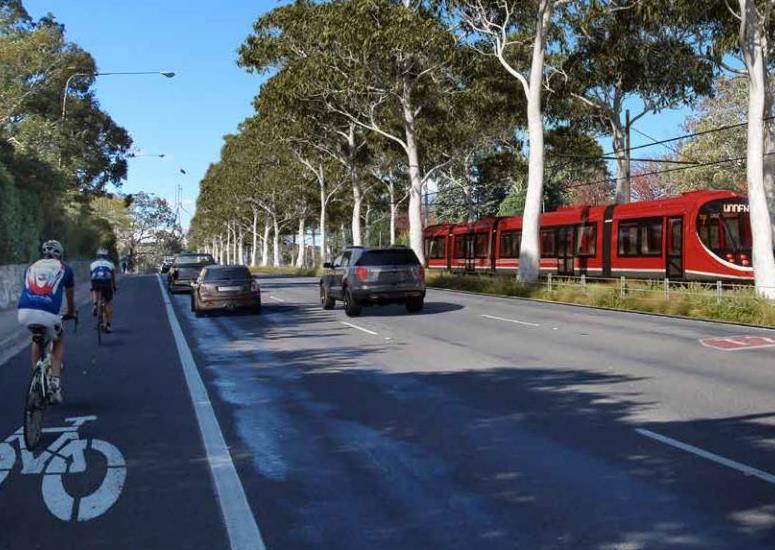
An artist’s impression of the Commonwealth Avenue median with light rail. Images: Transport Canberra.
Extending the light rail line to Woden through the Parliamentary Zone will cost up to $1.6 billion with construction scheduled to commence in 2020-21, depending on Commonwealth approvals, according to a mid-year update on Stage 2 released by the ACT Government.
The update confirms that the journey from Woden to the City through Barton will take 25-30 minutes as opposed to the 14-minute trip on the current Blue Rapid bus.
It also says the Government is considering grassed tracks, similar to that in operation in Adelaide, to conceal the rails within the landscape of the Parliamentary Zone, and simplified stops near landmarks such as Old Parliament House.
Windsor Walk in Barton is set to become a central linear park and continuous pedestrian spine connecting transport facilities, offices, a proposed retail plaza and landscaped recreational areas.
Minister for Transport and City Services Meegan Fitzharris said the ACT Government’s spending decision would be guided by a final business case for the project in coming months.
“Our business case can be finalised once we’ve worked through approval processes with the NCA and Commonwealth Government. However initial costings have been developed and are currently anticipated to be in the region of $1.3 to $1.6 billion,” she said.
“This is commensurate with the original cost estimates for the first stage of light rail, escalated to future dollars and reflecting additional costs associated with bridges, wire-free running, additional light rail vehicles and other factors.”

A transformed Windsor Walk in Barton.
Ms Fitzharris said that the Government was looking to have the business case approved in 2018-19, procurement in 2019-20, before construction starts in 2020-21, depending on Commonwealth support for the project, and associated planning requirements.
She said the next steps for the project included developing the design in close consultation with the National Capital Authority (NCA), making planning and environmental submissions, and undertaking further community and stakeholder consultation on the project.
$12.5 million had been allocated to progress the project through the 2018-19 financial year.
The update says the Government’s preferred lake crossing is the construction of a new light rail bridge between the existing Commonwealth Avenue bridges so existing road traffic capacity will be retained, and traffic flows will not be significantly affected.
In order to integrate the project with its environment, the Government is investigating similar sites overseas where the stop surface is integrated into the fabric of the area and has no canopy to obscure view lines. This type of approach is planned for the Old Parliament House light rail stop to reflect its iconic location.
It is also exploring a grass surface finish, similar to that in operation in Adelaide, that could be implemented along Commonwealth Avenue and Kings Avenue to conceal the rail within the landscape of the national boulevard. King George Terrace will be paved to integrate the light rail tracks with the new pedestrian environment, with a similar treatment envisaged for Windsor Walk.

An artist’s impression of Adelaide Avenue with a treed median and light rail.
Light rail will also have a big impact on parking in the Parliamentary Zone with the project initially displacing 130 spaces or 4 per cent of available parking. With the ability to pour 4000 people into the area during the morning peak hour, light rail will change the parking dynamics and facilitate the anticipated development of surface car parks, the update says.
The introduction of the light rail will change the demand for parking and helps with the orderly development of the area, in line with future developments identified by the National Capital Authority,’ the update says.
The project will impact 28 ‘ageing’ trees in the Commonwealth Avenue median from Lake Burley Griffin to Coronation Drive, but about 40 new trees would be planted between the carriageways, including 20 between Lake Burley Griffin and Coronation Drive south of the Lake. An ‘industrial looking’ Adelaide Avenue will also be landscaped and planted with trees.
The light rail Stage 2 project will be considered by a Commonwealth Parliamentary committee inquiry in the coming days.
Ms Fitzharris said the Joint Standing Committee Inquiry currently underway provided the ACT Government with an exciting opportunity to explain how light rail benefited Canberrans while supporting the Commonwealth Government’s national objectives and plans for the Parliamentary Zone.
“Light rail from the City to Woden will not only enhance access to the precinct, but will serve to demonstrate the Commonwealth Government’s commitment to our cities through its support of a modern, well-integrated mass transit solution, helping to make our nation’s capital an even more liveable and sustainable city,” she said.
“The ACT Government will continue to work closely with the Commonwealth to progress these planning approvals.”
The full mid-year update can be accessed at www.transport.act.gov.au/light-rail-project/city-to-woden-stage-two




















